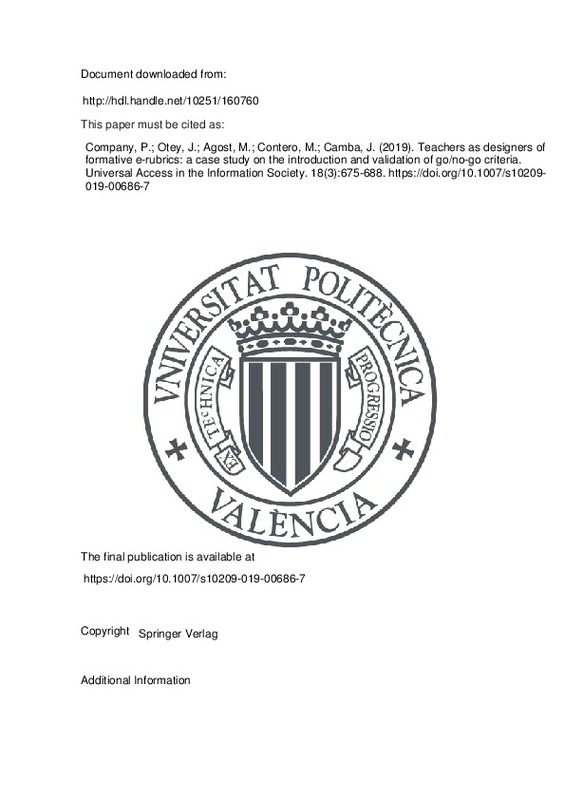Popham, W.J.: What’s wrong—and what’s right—with rubrics. Educ. Leadersh 55(2), 72–75 (1997)
Educational Research Service: Focus on: Developing and using instructional rubrics. Educational Research Service (2004)
Panadero, E., Jonsson, A.: The use of scoring rubrics for formative assessment purposes revisited: a review. Educ. Res. Rev. 9, 129–144 (2013)
[+]
Popham, W.J.: What’s wrong—and what’s right—with rubrics. Educ. Leadersh 55(2), 72–75 (1997)
Educational Research Service: Focus on: Developing and using instructional rubrics. Educational Research Service (2004)
Panadero, E., Jonsson, A.: The use of scoring rubrics for formative assessment purposes revisited: a review. Educ. Res. Rev. 9, 129–144 (2013)
Reddy, Y.M., Andrade, H.: A review of rubric use in higher education. Assess. Eval. High. Educ. 35(4), 435–448 (2010)
Company, P., Contero, M., Otey, J., Plumed, R.: Approach for developing coordinated rubrics to convey quality criteria in MCAD training. Comput. Aided Des. 63, 101–117 (2015)
Company, P., Contero, M., Otey, J., Camba, J.D., Agost, M.J., Perez-Lopez, D.: Web-Based system for adaptable rubrics: case study on CAD assessment. Educ Technol Soc 20(3), 24–41 (2017)
Tierney, R., Simon M.: What’s still wrong with rubrics: Focusing on the consistency of performance criteria across scale levels. Pract. Assess. Res. Eval. 9(2) (2004). http://www.pareonline.net
Likert, R.: A technique for the measurement of attitudes. Arch. Psychol. 22(140), 55 (1932)
Rohrmann, B.: Verbal qualifiers for rating scales: Sociolinguistic considerations and psychometric data. Project Report, University of Melbourne/Australia (2007)
Fluckiger, J.: Single point rubric: a tool for responsible student self-assessment. Delta Kappa Gamma Bull. 76(4), 18–25 (2010)
Estell, J. K., Sapp, H. M., Reeping, D.: Work in progress: Developing single point rubrics for formative assessment. In: ASEE’s 123rd annual conference and exposition, New Orleans, LA, USA, June 26–29. Paper ID #14595 (2016)
Jonsson, A., Svingby, G.: The Use of scoring rubrics: reliability, validity and educational consequences. Educ. Res. Rev. 2, 130–144 (2007)
Georgiadou, E., Triantafillou, E., Economides, A.A.: Evaluation parameters for computer-adaptive testing. Br. J. Edu. Technol. 37(2), 261–278 (2006)
Company, P., Otey, J., Contero, M., Agost, M.J., Almiñana, A.: Implementation of adaptable rubrics for CAD model quality formative assessment purposes. Int. J. Eng. Educ. 32(2A), 749–761 (2016)
Otey, J.: A contribution to conveying quality criteria in mechanical CAD models and assemblies through rubrics and comprehensive design intent qualification. Ph.D. Thesis, Submitted to the Doctoral School of Universitat Politècnica de València (2017)
Watson, P.F., Petrie, A.: Method agreement analysis: a review of correct methodology. Theriogenology 73(9), 1167–1179 (2010)
Kottner, J., Streiner, D.L.: The difference between reliability and agreement. J. Clin. Epidemiol. 64(6), 701–702 (2011)
McLaughlin, P.: Testing agreement between a new method and the gold standard—how do we test. J. Biomech. 46, 2757–2760 (2013)
Costa-Santos, C., Bernardes, J., Ayres-de-Campos, D., Costa, A., Costa, C.: The limits of agreement and the intraclass correlation coefficient may be inconsistent in the interpretation of agreement. J. Clin. Epidemiol. 64(3), 264–269 (2011)
Chen, C.C., Barnhart, H.X.: Assessing agreement with intraclass correlation coefficient and concordance correlation coefficient for data with repeated measures. Comput. Stat. Data Anal. 60, 132–145 (2013)
Bland, J.M., Altman, D.: Statistical methods for assessing agreement between two methods of clinical measurement. The Lancet 327(8476), 307–310 (1986)
Van Stralen, K.J., Jager, K.J., Zoccali, C., Dekker, F.W.: Agreement between methods. Kidney Int. 74(9), 1116–1120 (2008)
Beckstead, J.W.: Agreement, reliability, and bias in measurement: commentary on Bland and Altman (1986:2010). Int. J. Nurs. Stud. 48, 134–135 (2011)
Bland, J.M., Altman, D.: Measuring agreement in method comparison studies. Stat. Methods Med. Res. 8, 135–160 (1999)
Giavarina, D.: Understanding Bland–Altman analysis. Biochem. Med. 25(2), 141–151 (2015)
GraphPad: Interpreting results: Bland–Altman. Retrieved from https://www.graphpad.com/guides/prism/7/statistics/bland-altman_results.htm?toc=0&printWindow (1995)
[-]







![[Cerrado]](/themes/UPV/images/candado.png)


